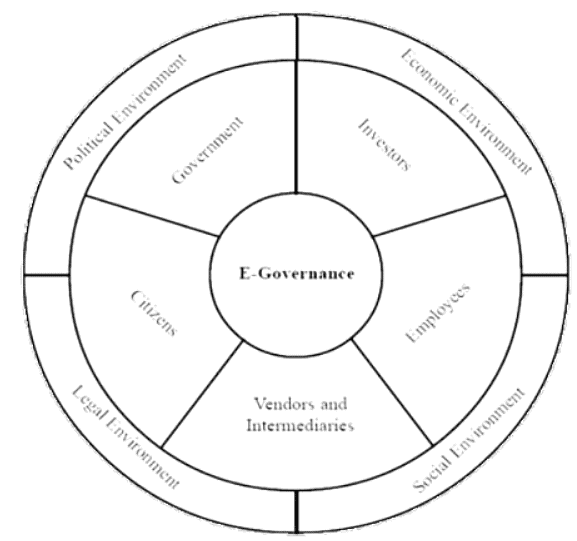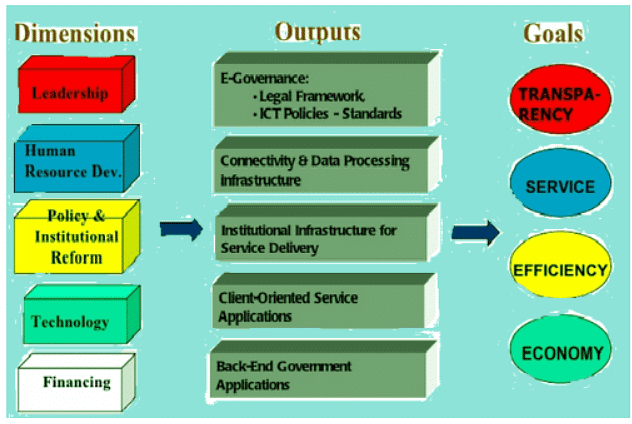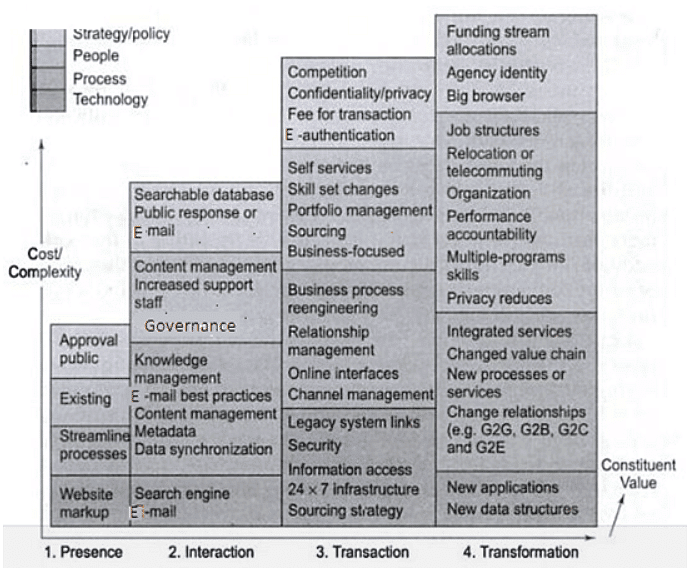E-Governance | Management Optional Notes for UPSC PDF Download
| Table of contents |

|
| Introduction |

|
| Concept of E-Governance |

|
| Historical evaluation of E-governance |

|
| E-governance in India |

|
| Issues in implementation of E-Governance |

|
| Recommendations to Tackle Challenges |

|
Introduction
- E-Governance has become an integral aspect of organizations in the globalization process. The increasing demand for transparency in administration, swift information transfer, more efficient performance, and improved public services has compelled organizations to adopt electronic means for business success. Leveraging information technology and e-governance innovatively can lead to enhanced organizational performance.
- The advantages of e-governance have a significant impact on public management, including improved access to services, reduced operational costs, advanced knowledge management, and strengthened coordination among government agencies. E-government represents a major evolution in web developments, presenting both challenges and opportunities for national governments within Internet-supported digital communities.
- The application of Information and Communication Technology (ICT) and e-governance holds vast potential for intermediary organizations in developing countries. The primary objective of e-governance is to facilitate and streamline governance for all stakeholders: government, citizens, and businesses. E-governance employs electronic mediums to support and promote good governance, aligning its purposes with the objectives of good governance. Good governance involves the application of economic, political, and administrative authority to effectively manage the business activities of a country at the national and local levels.
Concept of E-Governance
- E-governance refers to the effective utilization of information and communication technologies to enhance the efficiency, transparency, and accountability of information and transactional exchanges within government entities, between government agencies at various levels, and among citizens and businesses.
- In essence, e-governance involves the use of information and communication technologies across different government levels and public sectors to improve governance processes (Bedi, Singh, and Srivastava, 2001). Theoretically, e-governance signifies the transformation of the government's relationship with its constituents—citizens and businesses—and within its own organs through the integration of information and communication technology tools. Keohane and Nye (2000) argue that governance encompasses both formal and informal processes and institutions that guide and regulate the collective activities of a group, and it need not be exclusively conducted by governments.
- E-governance aims to leverage information and communication technologies to empower citizens in the decision-making process, providing them with opportunities for involvement. According to UNESCO, e-governance involves the public sector's use of information and communication technologies to enhance information and service delivery, foster citizen involvement in decision-making, and make government more accountable, transparent, and effective. E-governance introduces new management styles, decision-making processes, approaches to policy and investment, methods of education access, citizen engagement, and ways of organizing and delivering information and services.
- The overarching goal is to enhance access, accountability, and efficiency in government information and service delivery. E-governance has the potential to provide government information and services to the public and private sectors through the internet. Initiatives and innovations in e-governance can create a more democratic, transparent, and accountable framework for public and private operations. Governments in developing countries must establish an enabling environment for e-governance.
- E-governance, as a method of service delivery and information dissemination through electronic means, offers numerous advantages over traditional systems, including increased efficiency in governmental processes, enhanced transparency, anti-corruption measures, citizen empowerment, and increased citizen participation in governance (Jayaradha and Shanthakumar, 2003). Additionally, Ray and Dash (2015) argue that e-governance should encompass internal aspects, addressing the use of information technology to enhance the efficiency and effectiveness of internal functions, internal communications, and internetworking within the government.
- Internal aspects involve the overall transformation of government hierarchies to meet new requirements and expectations for efficient and improved services, as well as the simplification and rationalization of business processes to better serve stakeholders transparently and cost-effectively.
Variables of E-governance

Historical evaluation of E-governance
- In the nineties, with the technological advancements in internet technology, there was a global shift towards increased implementation of information technology by governments. Over time, both technology and e-governance initiatives have evolved significantly. The World Wide Web has provided people around the globe with ample opportunities to access information and services in diverse ways.
- There is a growing expectation among the public to obtain information and services online from both government and corporate organizations, influencing a new era of "e-citizenship." In India, the concept of e-governance emerged in the seventies, primarily focusing on developing in-house government applications for defense, economic monitoring, planning, and utilizing IT for managing data-intensive functions related to elections, census, and tax administration.
- During the eighties, the National Informatics Center played a crucial role in connecting all district headquarters. Since the early nineties, information technology has been complemented by information and communication technology to broaden its application in various sectors. Policies have emphasized reaching rural areas and fostering increased participation from non-governmental organizations (NGOs) and the private sector.
Conceptual framework of e-governance strategy

- The e-governance model can serve as a guideline for governments to determine where a project fits into the overall development of an e-governance strategy. An e-governance strategy is crucial for achieving corporate goals, and projects gain structural value for development when they are aligned with a vision and supported by policies. Anderson has outlined the process of implementing e-governance projects, emphasizing the approach of "Think big, start small, and scale fast."
- Thinking big is essential for establishing the overall vision and objectives of e-governance. Starting small is crucial for building immediate success and maintaining positive momentum, both internally and externally. Scaling fast is achievable with a well-thought-out strategy that ensures all necessary resources are available in a timely manner.
E-governance implementation

- To gain a deeper understanding of the e-governance space, researchers have developed various frameworks and models. Gartner, for instance, proposed a four-stage model for e-governance. In the first stage, known as "Presence," governments establish a minimal online presence.
- The second stage, "Interaction," involves reorganizing and enhancing online presence to include a searchable database of services, with government staff starting to use communication tools like email. In the third stage, "Transaction," governments provide services online, allowing citizens to benefit from government services, and governments use e-authentication and payment services for service delivery.
- The fourth stage, labeled "Transformation," sees governments integrating services across different levels and functions to offer integrated services from various departments. Gartner suggests that pace layers can be employed to develop a business application strategy that delivers a faster response and a better return on investment (ROI) without compromising integration, integrity, and governance.
Gartner's model of E-governance

- Layne & Lee proposed another e-governance model, emphasizing that e-governance is an evolutionary phenomenon and initiatives should be implemented in an evolutionary manner. According to their model, the initial stage is "Cataloging," where governments provide information online.
- In the second stage, known as the "Transaction" stage, e-governance tools revolutionize the way governments interact with their citizens. The third stage, "Vertical Integration," suggests that e-governance projects move from mere automation and digitization of existing processes to the transformation of government services.
- The final stage in the Layne and Lee model is "Horizontal Integration," where Information Technology tools horizontally integrate services across different functions of the government.
K. Layne, J. Lee Government Information

- The United Nations Organization introduced a five-stage model of E-governance in 2003 after conducting a survey.
- The first two stages of this model are similar to Gartner's model. In the initial stage, there is limited, basic, and static information provided through an official website or a portal.
- The second stage offers searchable databases and information related to laws and regulations.
- The third stage is recognized as "Interactive Presence," where government services enter an interactive mode with electronic signature facilities and multimedia capability.
- In the fourth stage, "Transactional Presence," government services are offered as online transactions, allowing inhabitants to avail and pay for services using government portals.
- In the last stage of the UN's model, "Networked Presence," government agencies are combined to offer integrated services from various departments.
- Another model suggested by Finger and Pecoud for e-governance is based on three different policy levels (local, national, and global), three different sectors involved (private sector, government, and third sector), three different policy functions (policy making, regulation, and operations), and three different degrees of making use of New Information and Communication Technologies.
E-governance in India
- India, with its diverse culture, traditions, languages, and geographical variations, faces challenges in socioeconomic benchmarks, particularly among marginalized sections such as rural and urban poor, women in rural areas, street children, and disadvantaged castes. The vulnerability of these groups has increased with globalization and political crises, setting back India's development. E-Governance and ICT initiatives play a crucial role in improving accessibility, reducing costs, curbing corruption, and providing assistance to these underserved groups. In the era of technological advancement, e-government initiatives have reached various sections of society, offering economic and social development opportunities, enabling participation in decision-making processes, and empowering the most vulnerable.
- India holds a strong position in implementing ICT in Asia, with global connectivity and advancements in the telecommunications industry positively impacting the country's fiscal growth. The government supports ICT-based industries through investment incentives, tax concessions, and the establishment of e-zones. The National Informatics Centre (NIC), founded in 1976, played a pivotal role in initiating e-Governance in India, with subsequent national and state-level projects addressing government service challenges. The National e-Governance Plan (NeGP) was launched in 2003 to make government services accessible, transparent, and efficient.
- Academic debates surround e-Governance, with discussions on the need for bureaucratic system changes with ICT use. Some argue that e-Governance enhances governance by reducing costs, disseminating information, promoting participation, and delivering services efficiently. Others emphasize the transformation of existing bureaucratic models. Concerns are raised about the impact of ICT applications on government processes, with the potential to bring vivid changes or transform institutions rather than merely automate or reform structures. Overall, e-Governance has emerged as a significant force in India, addressing societal challenges and fostering development.
Issues in implementation of E-Governance
- The implementation of e-Governance policies faces numerous obstacles, including insufficient funds, infrastructural challenges, limited manpower, citizen engagement, data management, legal framework readiness, and maintenance issues. A NASSCOM report highlights the rapid growth of e-Governance in India, particularly in Andhra Pradesh, Karnataka, and Tamil Nadu. To overcome these obstacles, experts recommend proactive steps addressing operational, economic, personnel, planning, and implementation challenges.
- Advanced technologies demand a novel approach to service and business process design, skill development, and flexible working practices. Structural inertia, resistance to change, and cultural barriers pose significant challenges. The transition from an organization to an 'e-organization' impacts structure, management styles, power distribution, and alignment.
- Companies adopting e-Governance need to develop customer orientation, redesign job responsibilities, redefine job dimensions, and adapt recruitment and selection processes. It involves identifying competencies for a technological environment, creating a performance management program, educating employees about new responsibilities, and fostering a positive work environment. Effective implementation requires changes in decision-making processes, a flatter organizational structure, higher delegation of authority, and alignment of the new vision with the organization's structure, culture, and strategies. Overcoming these challenges is crucial for successful e-Governance implementation.
Recommendations to Tackle Challenges
Appropriate strategies for e-Governance and information and communication strategies are essential to bring about changes in various internal systems of organizations. Studies have consistently shown that a highly motivated and satisfied workforce performs better than a demoralized and dissatisfied one. To address challenges in human resource management in the context of e-Governance, several strategies can be employed.
- Tapping into New Sources of Manpower:
- Explore new sources such as college campuses to find the right talent for e-Governance projects.
- Consider engaging HR consultancies to identify and recruit suitable candidates.
- Training and Skill Development:
- Recognize that existing manpower may not be immediately ready for deployment in e-Governance projects.
- Develop comprehensive training programs to bridge the skill gap and prepare employees for the changed work environment.
- Selection Process Design:
- Design a selection process that objectively measures the skills and competencies required for handling the new work style and job responsibilities.
- Implement methods that accurately assess the knowledge and skills necessary for the redesigned jobs.
- Leadership Qualities:
- Appoint an e-Governance implementation leader with strong conceptual and management skills.
- The leader should provide guidance, act as a mentor, and coach employees through the changes.
- Adapt leadership styles and approaches to effectively manage people in the dynamic and technology-driven work settings characteristic of e-Governance organizations.
These strategies aim to address workforce challenges, enhance skills, and foster effective leadership to ensure successful e-Governance implementation.
Conclusion
In summary, E-commerce refers to the exchange of information through electronic networks, encompassing various stages in the supply chain. E-Governance, on the other hand, involves the use of Information and Communication Technologies by the public sector to enhance information and service delivery, encourage citizen participation, and make government more accountable and transparent. In the developing world, e-governance holds a distinct significance. Achieving e-governance in India involves more than just computerizing back-office operations; it requires a fundamental transformation in how the government operates, necessitating changes in work culture, goal orientation, and existing processes. Developing a distributed and flat-structured e-governance system requires a shift in mindset at the higher levels of the system.
FAQs on E-Governance - Management Optional Notes for UPSC
| 1. What is the concept of E-Governance? |  |
| 2. What is the historical evaluation of E-Governance? |  |
| 3. How has E-Governance been implemented in India? |  |
| 4. What are the issues in the implementation of E-Governance? |  |
| 5. What are the recommendations to tackle challenges in E-Governance implementation? |  |

















